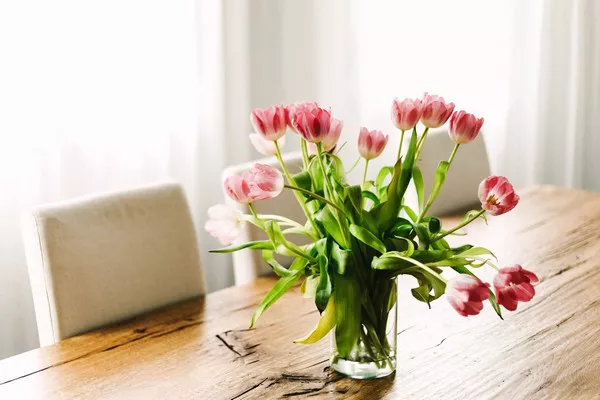Flowers, with their vibrant colors and delicate petals, bring joy and beauty to any space. However, keeping cut flowers fresh and vibrant can be a challenge, and watching them wilt can be disheartening. The good news is that there are several effective techniques and strategies to rescue flowers from the brink of wilting.
Understanding the Causes of Flower Wilting
Dehydration: One of the primary reasons flowers wilt is dehydration. When flowers are cut, they lose access to the water and nutrients they once received from the plant. Proper hydration is crucial for maintaining turgidity and preserving the freshness of cut flowers.
Bacterial Growth: Bacteria in the water can clog the flower’s vascular system, preventing water uptake. This bacterial growth accelerates wilting and shortens the lifespan of cut flowers. Addressing bacterial contamination is essential for prolonging the vitality of your floral arrangements.
Air Bubble Blockage: Air bubbles can enter the stem when cutting flowers, obstructing the flow of water. This blockage prevents the flowers from receiving the necessary hydration and contributes to wilting. Proper cutting techniques can help minimize the risk of air bubble blockage.
Reviving Wilting Flowers: Step-by-Step Guide
Quick Action is Key: The moment you notice your flowers starting to wilt, take immediate action. The sooner you address the issue, the higher the chances of successfully reviving your flowers.
Re-Cutting Stems: Trim the stems at a 45-degree angle, ideally underwater. This ensures that air bubbles do not enter the stem, allowing for efficient water absorption. Use sharp scissors or pruning shears for a clean cut.
Remove Excess Foliage: Eliminate any leaves that would be submerged in water. Submerged foliage can contribute to bacterial growth, hastening the wilting process.
Change the Water: Replace the water in the vase every two days to prevent bacterial growth. Use lukewarm water, as it is easier for the flowers to absorb. Clean the vase thoroughly before refilling.
Add Floral Preservatives: Commercial floral preservatives contain ingredients that nourish flowers, inhibit bacterial growth, and regulate pH levels. Follow the package instructions for the correct dosage and add the preservative to the water.
Hydrate Overnight: If your flowers are severely wilted, consider submerging them in water overnight. Fill a clean sink or basin with room temperature water and allow the flowers to hydrate completely. This process can work wonders for rejuvenating limp blooms.
Special Techniques for Specific Flower Types
Roses:
Remove Guard Petals: Roses often have outer petals known as guard petals that protect the inner petals during blooming. These guard petals can sometimes become damaged or discolored. Gently remove them to reveal fresh, vibrant petals.
Recut at an Angle: Roses benefit from a fresh cut at a 45-degree angle. This allows for better water absorption and helps prevent the stem from sitting flat against the bottom of the vase.
Tulips:
Trim the Ends: Tulips continue to grow after being cut, and their stems can become too long for the vase. Trim the ends at an angle to ensure the tulips receive water efficiently.
Use a Pin: If your tulips are drooping, insert a pin or needle into the stem just below the flowerhead. This helps the tulip stand upright by removing trapped air.
Lilies:
Remove Pollen Stains: Lily pollen can stain both the flowers and your clothing. Gently remove the anthers (pollen-bearing structures) to prevent staining and encourage longer-lasting blooms.
Cooling Technique: Lilies appreciate cool temperatures. If your lilies are wilting, place them in the refrigerator for a few hours. The cool environment can revive them and prolong their freshness.
Natural Remedies for Wilted Flowers
Aspirin Solution: Crush an aspirin tablet and dissolve it in the vase water. Aspirin contains salicylates, which act as a mild acid and can help water travel up the stems more efficiently.
Sugar Solution: Create a solution of one to two tablespoons of sugar per quart of water. The sugar provides nutrients for the flowers, acting as a homemade floral preservative.
Bleach Solution: Add a few drops of bleach to the water to inhibit bacterial growth. Be cautious with the quantity, as too much bleach can harm the flowers.
Alum Powder: Alum powder, available in the spice section of grocery stores, can be mixed with water to create a solution that helps flowers absorb more water.
Warm Water Immersion: Submerge the wilting flowers in warm water for 30 minutes to an hour. This can revive them by improving water uptake.
Long-Term Care for Cut Flowers
Proper Placement: Keep cut flowers away from direct sunlight and heat sources. Display them in a cool, shaded area to prevent premature wilting.
Avoid Drafts: Drafts from open windows, air conditioning vents, or fans can dehydrate flowers quickly. Place arrangements away from drafty areas to maintain their hydration.
Regular Pruning: Remove any fading or wilted flowers promptly. This not only improves the overall appearance of the arrangement but also directs energy toward supporting the remaining blooms.
Adjust Water Levels: As flowers absorb water, the water level in the vase may decrease. Ensure that the stems remain submerged, adding water as needed to maintain hydration.
Humidity Control: Flowers benefit from a humid environment. If the air is dry, consider placing a shallow tray filled with water near the flowers to increase humidity.
Conclusion
Saving flowers from wilting is not only possible but can become a rewarding aspect of floral care. By understanding the causes of wilting and implementing timely and effective techniques, you can extend the life of your cut flowers and enjoy their beauty for days or even weeks. Whether you opt for commercial floral preservatives or experiment with natural remedies, the key lies in consistent care and attention to detail. Embrace the art of floral care, and let your arrangements flourish with vibrancy and elegance. With the right knowledge and a touch of dedication, you can ensure that your cut flowers remain a source of joy and beauty throughout their display.


